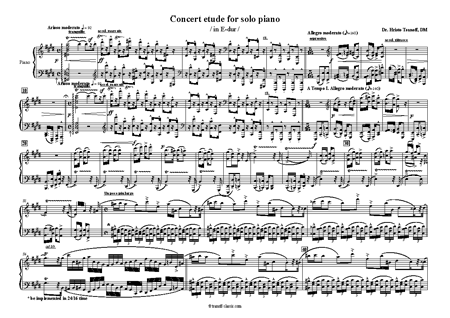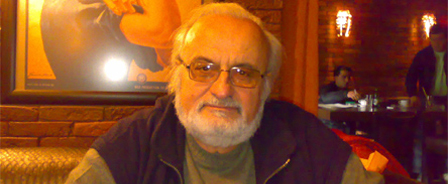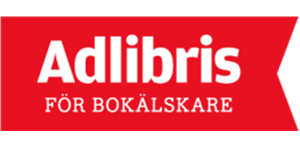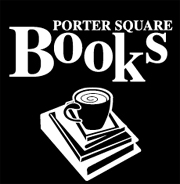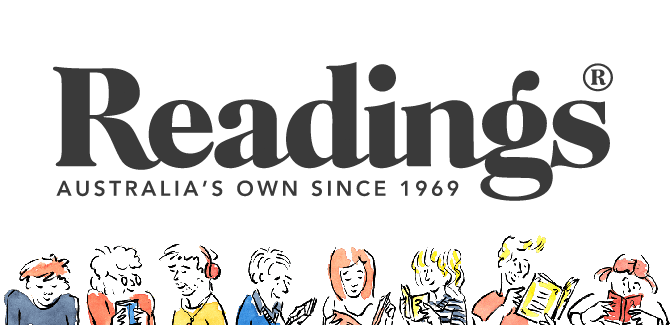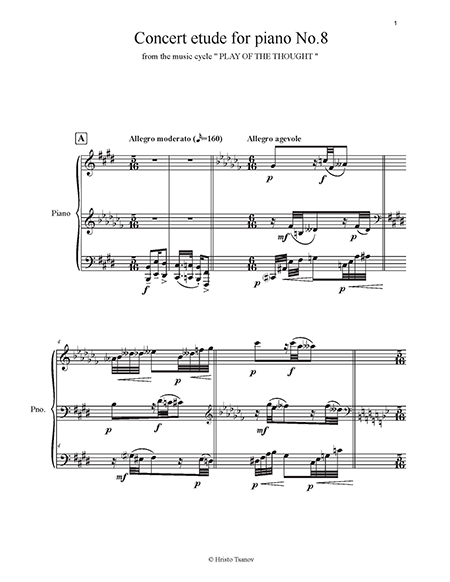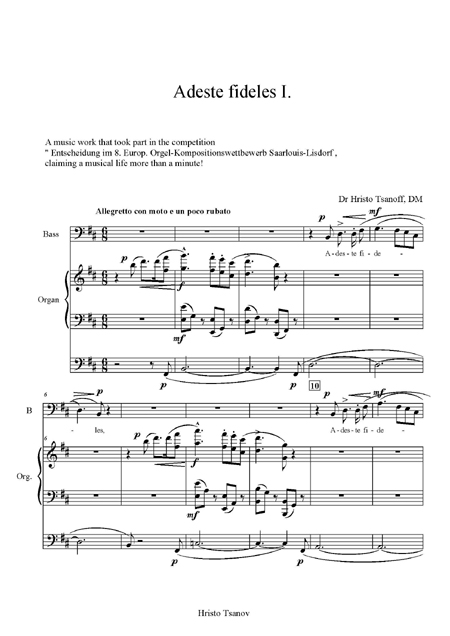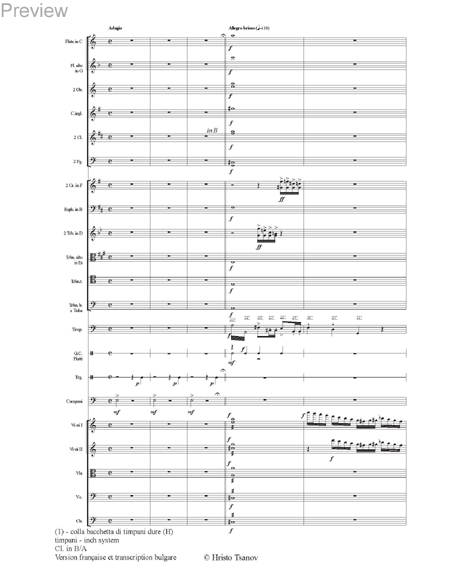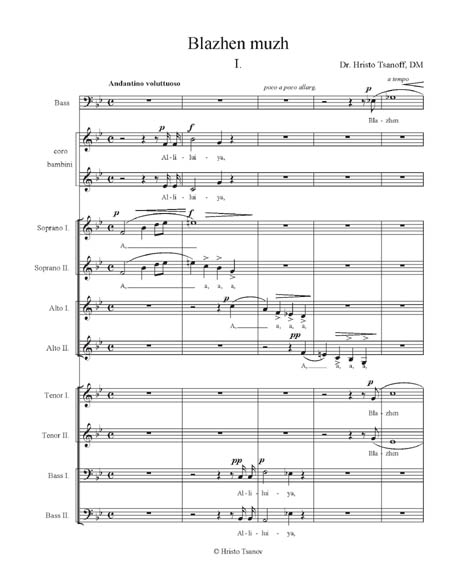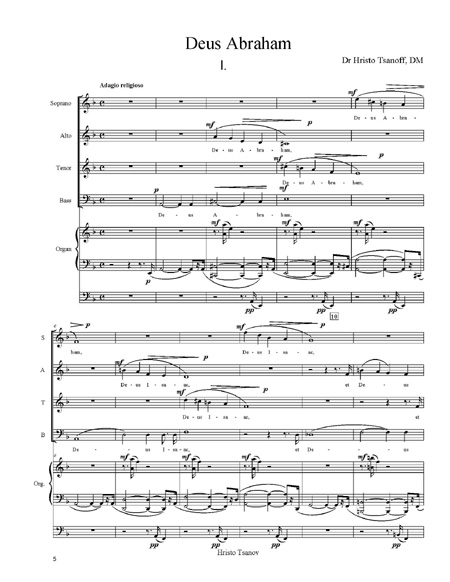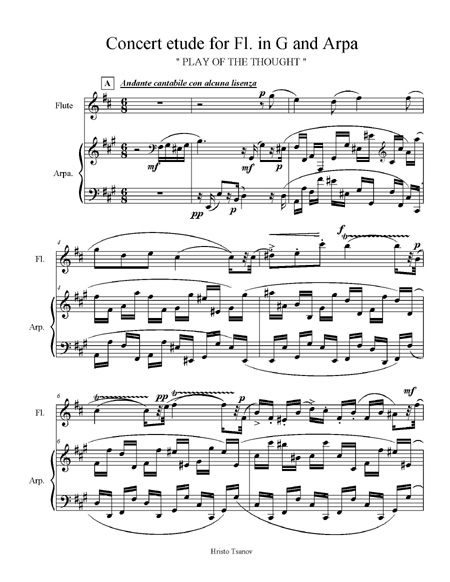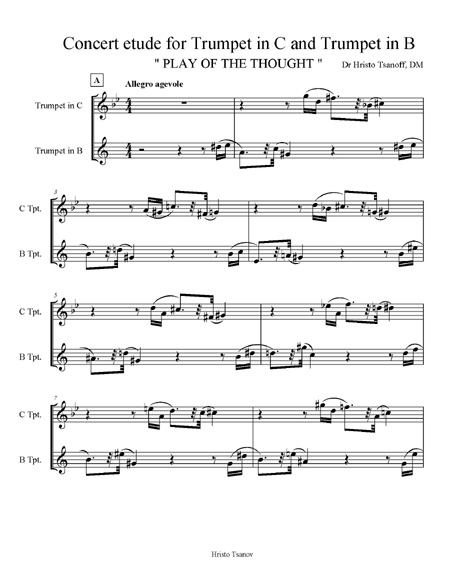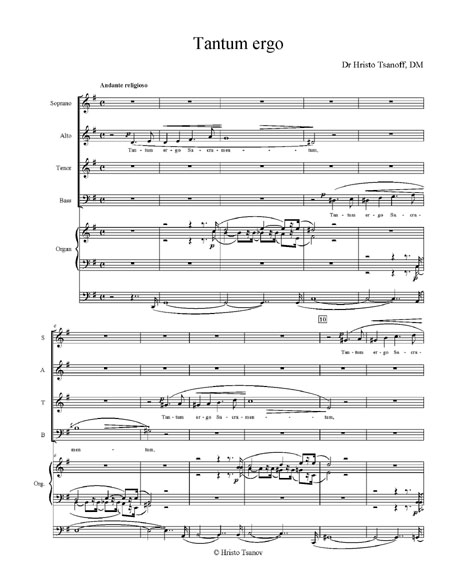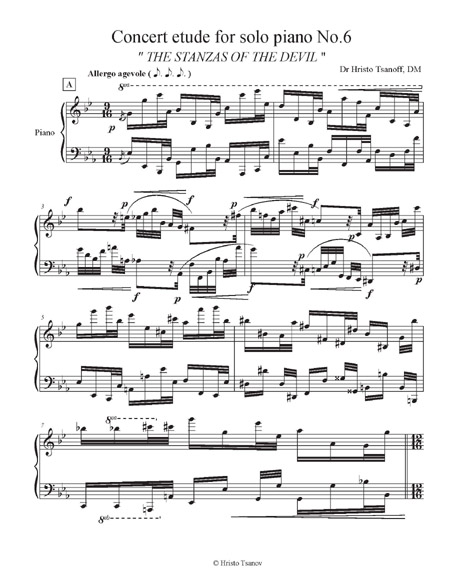IN MEMORIAM of my teacher
The descent of the Maestro Pancho Vladigerov is from the active and cultural city of Shumen, where his forefathers a native land were born and lived. The grandfather of the composer is called Panayot Koskaev, an inventor-garment maker, who had a little store at the bazaar of Shumen. Vasilka Kostakieva was his wife, she was also from Shumen. From generation to generation Vasilka Kostakieva was called Vladigerova and the composer's family name came from her. His father has accepted it. According to the family memories the origin of this name is: the grandfather of Vasilka, who was a craft-goods mish was a vociferous singer. He brought the nickname "titmouse" and as in that era many family names, came from nicknames. His son first became Vladigerov.
No.8
You can purchase an original copy of these sheets for a symbolic price, covering only the printing costs.
a bow to your bright memory!”
[ 13 March 1899 – 08 September 1978 ]
Hristo
This concerto etude is based on a theme by my teacher Pancho Vladigerov and is in his honor!
The etude is built in polytonality and polyrhythm, corresponding to the level of the performer!
/ measure: 302 /
06 March 2024, Wednesday - 13 March 2024, Wednesday
villa "Lina", v.Emona, Bulgaria
Please see a small part of this work in printed form [PDF version].
In a possible interest in the work, please contact us through our e-mail.
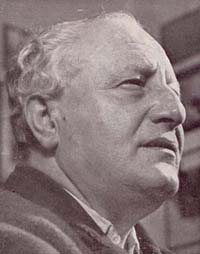 Panayot Kostakiev had two in heritors: a son Haralan, the composer's father whowas born in 1866 in Shumen and a daughter Vasilka, named after her mother. Panayot died too young and the great care for cultivation of the children fell on the young widow who even managed to give them an education. Vasilka's daughter graduated a secondary school and became a teacher in Shumen. She married Dimitar Bedeev, from Shumen, from who she had three children: Yanko, Vasil and Eliza.
Panayot Kostakiev had two in heritors: a son Haralan, the composer's father whowas born in 1866 in Shumen and a daughter Vasilka, named after her mother. Panayot died too young and the great care for cultivation of the children fell on the young widow who even managed to give them an education. Vasilka's daughter graduated a secondary school and became a teacher in Shumen. She married Dimitar Bedeev, from Shumen, from who she had three children: Yanko, Vasil and Eliza.
Harlan studied for a time in a secondary school but before graduating it, he went to Sofia. There he became an official for Grigor Nachevich, a political figure from the party of the concevatives. Around 1885, Grigor Nachevich was appointed minister prenipotentiary in Bucharest and took Haralan along with him. In the beginning, Haralan Vladigerov worked as an official-translator raising to a diplomatic post-legation secretaty. In Bucharest he took extra examinations and finished his secondary education. There he learned Romanian, French and Turkish. After a stay of 6 or 7 years, in Bucharest he came back to Shumen because of the deselection of Grigor Nachevich. He left for Laussane to study law. After an year, he moved to the University of Brussels and came with the title "a doctor of law". During 1895 Haralan Vladigerov came back to this country and began work as an assistant-prosecutor ( to memories of doctor Stefan Smyadovsky from Shumen, a coeval and a friend of Haralan ).
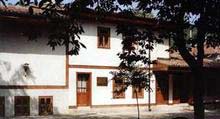
The composer's mother, Eliza Vladigerova, was born on 19 November 1869 in Odessa. Her father Leon Pasternak is a Mathematics professor. Besides science he is interested in shah and a passonate lover of music: he played the violin, and composed short pieces for violin and piano. Two of his compositions were published by Odesa's publishing house "Bernardi": polka "Philanthropist" ( devoted to his wife Ester ) and waltz "Shah competition" ( devoted to his daughter Eliza). When Eliza (the eldest of his 5 sons and 3 daughter) graduated a secondary school her mother died. After wife's death leon Pasternak left Odessa and moved to Zurich, Switzerland were he became a Mathematics professor in the Polytechnic. Eliza left for Paris to study medicine. Ivan Lechev was among her fellow-students ( he was father of the violinists Todor and Arseni Lechevi ), who discussed her to come to work in Bulgaria after Eliza finished her education.
Eliza Pasternak came to Bulgaria in 1895. She sat un as a doctor in Varna ( for about one year ), after that in Razgrad and Shumen. Here, Eliza Pasternak worked as a school doctor and a gynaecologist as self-employed. She was introduced to Haralan Vladigerov, publish prosecutor of Shumen, and she married him in 1898. Because the canons of the Orthodox Church didn't allow marrianges among orthodoxes and persons of different religions Eliza became converted to Christiantly, before the marriage ( at the marriage ceremony she was inscribed as Elisaveta L. Pasternak, doctor Orthodox ).
Soon after their marriage, Haralan and Eliza Vladigerovi bought the most beautiful house in town - the house of Nacho Popovich ( a rich man and benefactor from Shumen who had built a school and a community centre). The house was in "Full spring neigh bourhood".
When next year Eliza knew that she would have twins, she moved to her father in Zurich where, on 12 March 1899, she gave birth to first of the twins - Lyuben. Pancho Vladigerov was born on 13 March 1899. On 18 June 1890 the children were christened in Shumen, as they were inscribed in the birth certificates in Zurich - Lyuben-Rafail and Pancho-Danilo.
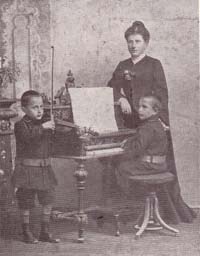
From Switzerland, Eliza Vladigerova came with a governess, a Swiss, who looked after the children for 5 years. When the children were six years old, Lyuben started to learn the violin and the younger brother the piano. Pancho was taught his first piano lessons by his mother, who later took a teacher for him. Ti was , Pavla Vaysman, the young pianist, graduated in Viena, who married doctor Alexander Zhekov from Shumen in 1909. He died in 1928. She had from him, two children Anton and Ekaterina. On the second year of teaching, in 1904, the two brothers participated in a public concert ceremony in Community Centre "Arhangel Mihail" ( Community Center "Dobry Voynikov" now ). On 13 May 1906, Haralan Vladigerov got a heart attack and died. The injured death of the father was a shock for the family. Eliza Vladigerova started an extremely hard battle for the happiness of her sons. In the summer of 1910, together with her sons, she moved to Sofia where she was employed as a doctor. From that moment on, teacher took his hard way to seizure of the musical art.
( 1910 - 1912y. )
After his coming to Sofia for two or three months, Pancho Vladogerov learned the piano with a teacher, a French woman, Soycheva ( after her husband ), after that he started the musical school where Henrih Vizner was his teacher of piano. His brother Lyuben Studied in the same school violin attached to Petko Naumov. Almost a the same time, he started study with Dobri Hristov who, at that time, was a teacher in the secondary mall school and was one of the most popular composers and theoreticians.
He bought a music-book in a hard cover and super scribed it in his cramped childhood handwriting:
"Music album of composition of Pancho Vladigerov, 27.02.1911 - Sofia, class 2A"
Then he cut "a seal" off hiss rubber saying P.V. abd put a seal on any place possible. In this music album the begging composer fixed about 20 opuses written in distored and so metimes incurred notes. On 26 December he finished a "Mazurka" for piano, devoted to "Dedushka" whit was the earliest ingeribed composition of Vladigerov. After that was a sonata for piano, devoted to "Henrich Vinzer", then comes next, "Bulgarian Rhapsody, devoted to Mr. Ivan Shishmanov", "Elegy" ( renamed later in "The Cry if the Earwig" ) devoted to the death of his cousin and others.
One of these earliest musical compositions came to light. "Actor Newspaper" from 5 May 1912 edited as a music application, the elegy "The Cry of the Earwig" with the following note:
"... where there in the smallest spark of talent, we edit the compositions above for encauragement to the young author"
In the Summer of 1911 Eliza Vladigerova moved to Vienna with her children. There she consulted the Austrian composer Robert Fux. He said that Pancho was a musical talent, who had all preconditions to advance, as Pancho was Slav he recommend him to go and study in Russia. The mother from Vienna to Kiev to meet the most famous musician in town Vladimir Pohalski, pianist, composer, conductor, of the Philharmonic orchestra and director of Kiev Conservatory. Pohalsky was moved by the attention and honour of Fux, a composer from Vienna. He recommended to Pancho to study in Paris Conservatory. After Kiev Vladigerovi visited for a short time Tiraspol, where she was with her grandfather, the father of Ester Pasternak.
After her return in Sofia, Eliza took up to secure a scholarship for Pancho in Paris. In this attitude Professor, doctor, Ivan Shishmanov, gave the biggest support a prominent scientist and ex-minister of education.
At that time, in the end of 1911 the famous French violinist Anrie Marto came to Bulgaria ( He lived in Berlin and he was a professor in the German Conservatory ). After he heard Lyuben and Pancho he persuaded Eliza to send her children off to Berlin and he promised his unreserved support. In June 1912, Pancho got a scholarship and Vladigerovi left for Germany.
( 1912 - 1918 )
In the Germany capital, the family put in the board of Schteinplatz at first. In July, together with Marto, thet spent the summer in the village of Oker, where Pancho wrote a few little pieces for piano. In the autumn of the same year, the mother, rented a small flat at Neuekantstrasse in Scharlotenburg, the residential district where in the Berlin Conservatory as well. After 2years, the family moved in a flat in the building of Deutsche Theatre at 12'Schumanstrasse which the people of the Bulgarian colony in Berlin playfully called Shumenstrasse. In the autumn of 1912, Eliza Vladigerova entered as assistant in Berlin Gynaecologist clinic of profesoor Paul Stasman. Because the children weren't 15 years old, they couldn't enter the conservatory, according to the rules.
Marto secured lessons with composer Paul Yuon for Pancho ( 1872-1940, brother of the famous artist Konstantin Yoan ). P. Yuon was born in Moscow. He finished composition in Moscow Conservatory with Taneev and Arenski, and after 1906 he was a professor of composition in Berlin Conservatory.
Again under Marto's protections Pancho became a private student of piano with Haynrih Bart ( 1847-1922 ), also a professor in the Conservatory, an instructor of piano classes, a personal friend and brother-in-arms of Brahms and Joachim.
Years of a serious and hard work followed. In the autumn of 1913 the young composer created "Sonata for violin and piano in Re-major" which was opus one in his creation. In the autumn of 1914 at the age of 15 he took up in the conservatory named by Staattiche akademische Hochschule fur Musik, where he didn't pay fees, being gifted. In his first year, of study he composed his second opus "Four pieces for piano". In the middle of 1915, Paul Yuon was mobilized in the army. He recommended him to his next teacher of piano, Kreuzer, who was delighted by him and he didn't take any money from him.
His look was charged to the Academy of Arts-Akademie der Kunste, whose composer's section was called maistershule. There were the higher exprertly classes of composition. His cessation of the competitive examination was brilliant and he was accepted in the Academy. From the autumn of 1915 to he summer of 1916 he studied in an expertly class of composition of Fridrih Gernscheim ( 1939 - 1916 ). Unter his guidance, he creation-variations, on one Bulgarian Theme - "Dear Motherland".
In september 1916 Gernschein died and Pancho moved to the class of Giorg Schumann ( 1866 - 1945 ). There he finished his trio for violin, violoncello and piano in Si-flat minor, op.4 nad next year, six lyric pieces on Dora Gabe poetries and the ballad "Crazy Gigya" by Pencho Slaveykov.
In the beginning of 1917 he became a student of piano with Leonid Kreuzer ( 1884-1953 ). Born in Petersburg, Kreuzer studied in Petersburg Conservatory with Glazunov and piano with the famous Russian pianist and pedagogue A.N.Esipova.
From the summer of 1917 to 3-rd August 1918 he wrote his first concert for piano and orchestra, and for, that period he, finished his seventh opus "Narrative poem" for violin and piano too. In the beginning on September, Pancho, his brother and his mother moved to Bulgaria.
( 1918 - 1920 )
In mediately after their arrival in Sofia, the brothers Vladigerovi enrolled in the army. After a short training they were included in the musical command where all young musicians served their time as soldiers. Lyubenbecame a member of an orchestra and Pancho became a librarian. On December 1919 in the soldier club, they gave their first performance in Bulgaria with creations only by Pancho: The violin sonata, pieces for piano op.2, the variations for piano op.3, the lyric songs op.5 performed by Pencha G. Toromanova. At that time a happy notice arrived: Pancho Vladigerov was a prize winner of the Mendelson's reward for his first concert for piano and orchestra op.6.It was given annually by Berlin Academy of Arts for the best composition of young composer. During 1919 and the beginning of 1920, the brothers Vladigerovi gave a lot of concerts and in some of then young violinist-virtuoso Sasha Popov participated. He served in the army as concert-master too. At the same time the violinists Todor Torchanov and Boyan Konstantinov, the pianists Andrey Stoyanov and Ivan Torchanov the violoncellists Ivan Tsibulka with his trio ( Ivan Tsibulka, Yan Koch and Andrey Stoyanov ) and a quartet Schwertcher gave cibcerts. At this same time Tsanko Tsankov began his constructional activity. Tsanko Tsankov wrote for concerts in Plovdiv about the brothers Vladigerovi in an article:
"As a composer Pancho stays was up to the mark with the big western musicians ... I haven't seen, to this day, such kind of devilish skill and penetrating ... "
An other notice from 1919 by Orphelin ( nickname of the teacher of music Alexander G. Dorosiev ) says:
"Marvellous gift! Violently dramatic interpretation! You take possession of souls of listeners you give life to actors and support those who, like you, fell the music!"
But the talent of Vladugerov's creations provoked malice and disparagement, coming to disavowal of his creation. A so-called musician signed with the nickname of "Carmen", criticized Vladigerov
"This musical composition ( "In National Tone", op.7, No.2 ) proves most crearly that Pancho Vladigerov s a musical impressionist and to this cause he will never be fully national composer."
He completely renounced Vladigerov as a prianist.
On 3 January 1920, in the Army's club, the Guard orchestra, conducted by Maestro G. Atanasov, gave the conctructional concert by Vladigerov. In the first part, the archestra showed the two impressions: "Longing" and "Passion", op.9. Lyben played the violins sonata, op.1 and Sasha Popov cares op.9, No.4, accompanied by Pancho. In the second part, Vladigerov showed his the first concert for piano with his orchestra. The constructional concert by Vladigerov had such a great seccuess that ( 18 January ) it was repeated in the National Theatre Hall Soon, where King Boris III was present.
In March 1920 Pancho Vladigerov finished his national service and together with his brother and mother moved to Berlin.
( 1920 - 1932 )
The years when the composer breeded.
In April 1920 the brothers Vladigerovi was in Germany again. In the end of 1920 Vladigerov for the second time took the Mendelson prize his three orchestrations op.9: "Longing", "Passion" and "Suprise". In January 1921 completed the concert for violin and piano in Fa-minor, op.11.
On 5 march 1921, the famous German violinist Gustav Haveman realized the concert for violin with Berlin Philharmonic orchestra conducted by Fritz Rayner, in the big "Beethoven Sall"
St. Denchev, in the newspaper "Sofia's echo", from 1 May 1921 says:
"... In the end of concert the young composer called in on the stage with thee long applanse ..."
In the newspaper "B.Z. an mittag" from 7 march 1921, the famous musical critic Adolph Weissman says:
"... On Saturday one radiant air warm us Fritz Reiner, the first conductor of Drezden Opera, substitute of Shuh, gives one serenade of Leo Weiner ( Hungarian ), which he is invated Brahms, Wagner, Bizet and Smetana, to one talkative melting. After that, is showed one new violin-concert in Fa-minor by the young 21 year old Pancho Vladigerov. This concert is not only mature production but and genius flowing on one strong sensitive imagination ..."
In newspaper "Berliner bursen courier" from 8 March Berlin critic Orsen Bee says:
"... Now, comes one novelty violin-concert, op.11 by Pancho Vladigerov, young and talented Bulgarian. Blow, completeness, wealth. "
On 17 march 1921, Vladigerov performed his first concert for piano and orchestra, with Berlin philharmony conducted by Arthur Lowenstein.
On 23 April 1921 the Wien Philharmonysts, conducted by Heraklit Nestorov ( 1896-1940, Bulgarian composer ) showed one "Novitaten Konzert" ( concert novelties ) in "Grosser Musikverein Saal". They showed: "Legend" op.8 for tenor and orchestra, and the three orchestra tions "Longing", "Passion" and the symphony "One summer day" by Heraklit Nestorov. This is the first all concert of Bulgarian symphony music in foreign country.
For this peiod of 12years, to his returninBulgaria,he wrote the scenic music for 11 pieces of Deutsche Theater. He created his "Bruleska" for piano and violin in 1922. In the masterpiece - famous "Rhapsody Vardar", op.16 for violin and piano remaked in 1928 for the big symphony orchestra.
At this period German "Polydor" and "Odeon" printed gramophone records with creations by Pancho Vladigerov. The Wienna's company "Universal Edision" concluded agreement with him for 10 years.
In 1927 Vladigerov visited Paris, where showed his first concert for piano and orchestra, conducted by Alber Doayen on 30 March.
In spring of 1928, in Prague, took the Bulgarian music festival. The festival uncovered of Dobry Hristov ( alumnus of Prague Conservatory and student of Antony Dworak ) on 24 march, on theme "Bulgaria and its tone art". After that is consisted a chamber concerts with this program:
- Fugue in Si-flat minor for clarinet, corn inglish and bassoon by Tsanko Tsankov
- Sting quintet by Pavel Stefanov
- Sonata for piano by Andrey Stoyanov
- Songs by Dobry Christoff and Petko Naumov
- "Underactions" for piano by Heraklit Nestorov
- Pieces for flute and piano by Boris Kochev
- Pieces for piano by Vasil Bozhinov ( was born in 1888 in Stara Zagora, studied with Max Reger and Alois Haba, lived in Prague)
- "Horo and ruchenitsa", op.18 for violin by Pancho Vladigerov
On the next day 25 March, in "Cream hall", is showed a second concert of Bulgarian creation. Czech philharmonic conducted by Frantisheck Stupka showed:
- Symphony in Sol-minor by Nikola Atanasov;
- "Balkan Mountain suite" by Dobry Christoff;
- Concert for violin and orchestra No.1, op.11 with soloist Lyuben Vladigerov;
- "Rhapsody Vardar", op.16 by Pancho Vladigerov;
- "Thracian dances" by Petko Staykov;
- Christina Morfova showed arranged of Bulgarian national songs;
- "The first cooks crowed" - D. H. Georgiev;
- "Begin to swing Ganka" and "Kindled" - L. Prokopova;
- "In roll" - T. K. Pandev.
"Rhapsody Vardar" is showed, for first time, in its orchestra from, on the concert. In book1, first year, in 1924, on bimonthly publication in Russian, Vl. Goncharov ( the father of long standing choir-master of the Sofia National Opera D. Goncharov ) says:
"... A lof of interesting artists: a violinist and a composer - a pianist and interesting, luscious music with various modernism ..."
In 1932, Vladigerov got a letter from Nikola Abadzhiev, professor and director of Musical Academy in Sofia, who offered to him professor's job.
( 1932 - 1960 )
On 5 December, recently after his completion, the Opera orchestra showed a big concert of creations by Pancho Vladigerov, conducted by Mosey Markovich Zlatin, the general conductor of the opera. He played the second concert for piano and orchestra and the composer was a conductor on "Rhapsody Vardar" and "Seven symphonic dances".
The first creation when he wrote after his return was the concert overture "Earth", op.27. To 1940, Pancho Vladigerov contract, after that a regular professor, from 1951 he was only a professor to composition. On 3 February 1934, he played his second concert for piano with Bucharest philharmonic orchestra, conducted by Dzholdhe Dzhordzhesko. The newspapers "Adevaru", "Lupta" and "Kurentul" published fanonrable comments for his creation.
In the begging of 1935, Vladigerov visited Zagreb philharmonic orchestra, where he played his second concert, conducted by Lavro Matachich. On 25 January, the Zagreb newspaper "Fresh news", published a big feature of composer B. Papandopulo, where he says for a big success of one musical talent, who is at the height in the hey-day.
On 4 August 1933, in the composer's family, was born his an only child - son Alexander to who he devoted one of the most successful pianoseries "The Shumen miniatures".
In 1935, he started his first opera "King Kaloyan" of libretto of Fani Popova-Mutafova and Nikolai Liliev. He worked besides with exceptionally, creative tension to created one musical composition.
On the next year the opera is finished and played on the scene of Sofia Opera. After the opera "King Kaloyan", P. Vladigerov created other spectacular creation - the third concert for piano and orchestra, op.21 - 1937.
From 1936 to 1942, Pancho Vladigerov is a Bulgarian representative in Permanent council for international collaboration of composers ( Conseil permanent pour la cooperation internationale des compositeurs ), created in 1934 of Richard Strauss. This organization is with the purpose to take care for copyrights and for propaganda and diffusion in Europe, of the creation by the composers.
The president of the Permanent council is Richard Strauss ( Germany ). The second presidents are Adriano Lualdi (Italy ) and Yan Aterberg ( Sweden ), as members are delegates of 20 Europe ciybtres.
In May 1937, Dresden Philharmonic, conducted by Paul von Kenmpen, showed "Rhapsody Vardar". On May 1938 the orchestra of Stuttgart Opera showed the third concert for piano and orchestra, directed by Herbert Albert.
Vladigerov devoted his first symphony in Re-minor, op.33, created in 1939, of Josev Marx ( the famous Austrian composer ).
In 1946 he finished the ballet "The Legend for Lake", op.47. On 3 March 1947, the Bulgarian colony in Vienna, organized in a big concert hall "Music-ferein", Bulgarian concert with creations by Pancho Vladigerov on the occasion of holiday for Liberation of Bulgaria. There is showed the third concert for piano, with soloist the author and a conductor Rudolph Moralt.
In February 1948 he visited Stockholm where conducted Carl Garagully, he showed his third concert for piano and orchestra.
The composer experienced a grievous loss. On 8 September 1952 died his mother - doctor Eliza Vladigerova. On 14 January 1959 died his wife.
On 9 April 1959 for 60 anniversary of one composer, in hall "Bulgaria" the Sofia National philharmonic, conducted by composer'sson showed "Jewish poem" and "Concert for piano and orchestra" No.4 with soloist P. Vladigerov and Symphony No.1.
On 8 September 1978, the big Bulgarian composer, departed from this world.
Dr.Hristo Tsanoff, DM
27.02.2006
The national songs and melodies, that Vladigerov used for his themes, were the most popular moods in our national music:
- Aeolian ( natural minor );
- Ionic ( natural major );
- A lot tipical of Vladigerov is Frigian mood, that makes his music elegiac;
- Continuously uses the different sound lines consists of interval enlargement second;
- In the later years of his creation he often uses one very tipical for our music intonation - the Aeolian cadenza with tone down ( for example Do-Si-Sol-La ).
Bulgarian Rhapsody "Vardar" op.15
Is notified that Bulgarian Rhapsody "Vardar", initially, is composed for piano and violin, in 1922. Among, the violin musical compositions by Vladigerov, the most important is the famous Rhapsody "Vardar", op.16. With its considerable provisional subject the beautiful musical images and perfectartfrom, the Rhapsody is real masterpiece.
At the end in October 1922, in Berlin, Vladigerovis met with tho his Bulgarian friends ( one of them - the artist Constantine Starkelov, stardet to sing national songs ). The melody, of one song, especially liked of the composer and he recorded it. Under the stress of his plough of Rhapsody for piano and violin, uses for a maintheme this song. On 13 December 1922 it is completed. The song, which Vladigerov uses for basic theme in a musical composition, is regarded as Macedonia national song and for that reason he called the Rhapsody on the famous river Vardar, the symbol of Macedonia. Later, however is determined, this is a patriotic horo song by Dobry Christoff, wrote in the spirit of the Macedonia national songs- "We are Bulgarian" wrote by L. Bobovsky from the collection "Mountain songs" by Dobry Christoff, publishing in 1912.
The litte binary song consisted of 16 times ( with repeat of the two parts ) by Dobry Christoff in 5/8, Vladigerov is written innotes in 5/16. Interesting is this, he isn't saw the notes of an amateur easy can be understood in tipical for Macedonia songs eight beet time. However uses them in first and second part of the Rhapsody, Vladigerov chahged its melodions profile - in the second, forth, eight and tenth time. By reason these changes, the song lost partly its Macedonian-folklore character, its melodions line becomes more flowing and it assumes most artistic and closer to the melodions style by Vladigerov, arpect. The original by Dobry Christoff and the theme by Vladigerov arein slow time, and five beat time hasn't got dancing horo character of known "Paydushko". In this time, the five beat time shows nearness with slow eight beat time. This nearness is more underlined with the accent on fourthbeat on the five beat time. By reson, of Vladigerov, this time is look up not as binary ( 2+3 )as tearbary consisted of ( 2+1+2 ) time, as Vladigerov for first time uses in his creation national theme in an irregual time.
The Rhapsody starts with a four-time thematic introduction of piano, after the violin inlow register on string "Sol", shows with the piano the main theme, after it is repeat ( octave louder ), as this time theviolin, plays inchords and double notes. The bright, expressive melody with its ponderous rhythm sonorounharmonies and pathetiallu raised character, shows maestroso mood. A little past the lime becomes livelier the rhythm - more out line and the violin devepops the second part of the theme, which has warm, lyric - nostalgic nuance.
The first part of Rhapsody finished with delay of the time and gradually of sonority.
The second time is quick ( time allegro-vivace, time 2/4 tonality Mi-minor, of the same name of the main Mi-major, same name of the composition ). In the first four limes, Vladigerov applies on interesting sound-rhythmical effect on the violin - knocks with the fold make on the first and third wuaver and they alternate with chords pizzicato in the left hand on second and fourth quaver. After rhis affective and determined entry, is unleashed optimistic horo - episode. In all middle part, the composer uses for theme some national goro melodies, developed with a fine sense and taste, comformable to specific requirements of the musical duet, applied some tipical skills of our national creation - briefly grace-notes, mordents and shakes, constantly leaping of top tone, which opens melody in to basic tone, sounded as iso, pizzicatos in chords-reminded playing on the pandore. All this, gives particular ariginality on the violin. To the middle of the horo part of the Rhapsody, Vladigerov applies more one original idea -similarly is unique in the solo violin literature. After one descending, tremolo glissando, the violin finishes in the lower register on the clean quits ( "Sol" from little and "Re" from the first octave ) on the empty fourh and third string. In continuation of the two time of time vivace, with out too stop motion on the bow on the two strings, the fourth string with the left hand is begun glissando with clef "Fa" and after on "Mi" of the little octave. This case is marked as especiallyinteresting, in the section on the violin in the capital work of Russian musicologist D. Rogal Levitsky "The modern orchestra". Long time this low "Mi" on the empty fouth strong continue to soundsas rhythmical iso on motion on two octaves higher melody. After 40 times is accomplished back beginning, on the fourth sting from "Mi" to "Sol" - again it the time of playing. All that, has contact with our instrument national music, showed of a rebec, abagpire or a Pandora, in whion sounds one low iso tone. The composer introduces of fhythmical iso and modulation from "Sol-major" in "Mi-major" and back. To the end of the middle, the part of the violin becomes the great principal theme, which is repeated as the first part. In the conclusion ( Coda ) on the Rhapsody, this theme sounds again in other one greater, raised aspect, as anthem for glorification of the Mother country.
The Bulgarian "Rhapsody Vardar" was showed, for first time in1923 in Berlin, of his author Lyuben Vladigerov ( violin ). In Bulgaria forfirst lime, it was sounded, in the end on September 1924. It is showed of the two brothers. In 1926 the piece was published of "Universal Edition", later on the record of the company "Polydor", Berlin. In 1928, Vladigerov orchestrates the "Rhapsody Vardar" and of this time it is samo popular with its two versions. The orchestra version is completed on 29 January 1928. With its welthy ideological emotional content, with its deep-national nature and perfecy art form, the Rhapsody shines as one of the most brilliant precions stones in the treasure house on the our national musical culture. It can be attached to the gorden fund on the our musical classic.
"Rhapsody Vardar" is constructed of three parts: The principal theme of Rhapsody ( in first and thind part ) is the horo song by Dobry Christoff "One and only cry is heard" in the spirit of the Macedonian national song in the 5/16 time. After fourth time loudly prelude, on the all orchestra on the motive, gone of the beginning of the theme the violins in the low register and the word-winds: a corn anglias, a clarinet and a bassoon - strik up real theme ( in "Mi-major" ) it sounds maestroso and emotion. The second time the theme passes in all orchestra and the loud dynamics and the tense sound of the trumpets and other bass-winds exalt its patherial.
A little past of the development of the theme, the music assumenland-scene-deseriptive and lyric character. The first part of Rhapsody completed calmy, in quiet sonority, with title initative voices in different instruments
In quick time ( Allegro vivace ) and time 2/4 begins the middle ( the second ) part of the Rhapsody. It is themes and variations-formulates on a few national horo motives, which the composer develops with exceptionally, delicate artistically feeling and sense for limit. Despite the thematic multiple, Vladigerov attains brilliant construction and unity of bright national melodies. There his melodions invension, as thong combines, with an intonation and colourfur essence of the national music.
The music in this part is fresh, energetic and primistic and it suggested the idea for an inexhaustible, vital energy, live iness of the spirit and an optimism of the Bulgarian people. After the horo element of the middle part as generation of the basic idea of the musical composition, again is showed the basic pathetic theme ( third part ). In the conclusion of the creation it sounds expecially power full, maestroso and majestic in all orchestra, as real anthem apotheos and power.
For the first time the "Rhapsodi Vardar" for orchestra, is showed on 25march 1928 in Prague, of Czech Phylharmony conducted by Frantishek Stupka. The first performance in Bulgaria is on 30 July 1929 in Varna of Symphony orchestra to Sofia State Musical Academy, conducted by the composer.
"Bulgarian Rhapsody Vardar" in the orchestra variation is showed on the concerts in: Berlin, Salzburg, Dresden, Utrecht, Philadelphia, New York, Milwaukee, Chicago, Torino, Vienna, Budapest, Paris, Stockholm, Prague, London, Helsinki, Goteborg, Copenhagen, Leipzig, Breslau, Beograd, Ljubljana, Athens, Anvers, Oslo, Bucharest, Waldenberg, Moscow, Cologne, Stuttgart and Hamburg.
Rhapsody " Vardar" is printed of "Universal Edition" - Vienna, the state company "Education and art" - Sofia and "Muzgiz" - Moscow. It is published on the record of German company "Polidor" in 1929.
Be sides, a Rhapsody "Vardar" has author's transcription for violin and orchestra ( 1951) in which version had only one performance and couldn't established, as for piano for four hands ( 1951 ) and on two hands ( 1955 )
17 April 2006
v. Emona
Bulgaria
Bulgarian suite, op.21
"Bulgarian suite", op.21 for orchestra is the first orchestra composition which continues the deeply national and democratic line of the Rhapsody "Vardar".
It is an expression of the patriotic feeling of the composer which inspired him, for write out ( the suite brings dedication "To the my Motherland").
"Bulgarian suite" is finished in 1927. Although "Vardar" had a orchestra version later of "Bulgarian suite", the last rests of the same creation principles of the violin original of the Rhapsody.
"Bulgarian suite" consists of four parts:
- Quazi marchia
- Song
- Horo
- Ruchenitsa
The parts are orderly to suite principle for contrast in time and general character of the music. This, what unite them in one composition, is the general creation method and stile, the only art plan and identity the means of expression.
Constructive the fourth parts are constructed in ternary form - with one or two themes. The suite cycle is opened with the first part, which begins straight with the theme. The national song, used for the first theme of the part has optimistic horo character. Rehearsal in harder marching tempo and wears in thick orchestra tissue, it acquires the bravely-energetic and advancing expressiveness. The development of the theme, of which it gets new melodious, harmonious, counter-point and orchestra nuances, saves energetic, marching mood.
In the middle part of the part, the second theme ( too national song ) in the beginning strikes up of the oboe is lyric. The third part ( reprise ), again returns the marching mood, which in the coda assumes solemn character.
In the second part of suite "Song" - shows one of the pick of the lyric, great in sight of Vladigerov. It is a classical model of the Bulgarian music, of the deep heart-felt and figurative lyrics, showed one highly artistic manner, the beauty of the Bulgarian land.
The thematic base of the song is one author's motive of the our melancholy, slow songs with typical interval in cremental second.
On this motive is constructed the short flaming introduction, which finished with cadenza on solo-violin. After solo, the oboe as if start singing this heart-left melody. It puts the beginning of its intensive development, as there tangibly is showed one deep, nostalgic feeling.
In the process of development of theme, realized skilful of the point of view of the symphonic construction, this mood is showed, gradually. In the middle part, where hasn't got a new theme, it develops in patriotic effusion of clean and strong love to native land. After this culmination, the tension decreases end the third part of the piece, moves us in its carm, elegiac atmosphere again.
In 1928, this second part was arranged for violin and piano and received diffusion in Bulgaria and abroad ( in the meantime in Buenos Aires ).
In 1951, Vladigerov makes the transcription of the Song for violin and orchestra, latter for violoncello and piano. The most notable singer of the song for violin is the universally known violinist David Oystrah.
The third part of Suite has horo character. It begins with a little thematic introduction with harsh, sharp and, after which the first violins show the theme - the national song "Milke, the dear uncle". After this vital and energetic melody, was modified repeatedly, however it confirmed the bright national - dance atmosphere. With the solo of oboe, which begins to play the national melody in 5/8 time, begins the middle part of the part. Lyrical - dance character on the theme determines there, and one finer and parti-colored orchestra stuff. The reprise, again carries the vigorously mood and the massive orchestra sonority, which is compressed in the end of the piece especially.
The fourth final part of "Bulgarian Suite" is constructed from beginning to the end of the time of Ruchenitsa 7/16. This the most famous Bulgarian national dance "Vladigerov is defended in a few creations, of different styles". He writes the Ruchenitsa, for first time, in 1925. The second paraphrase, op.18 for violin and piano.
The Ruchenitsa, of the Suite, begins with a little introduction, after, the solo-oboe shows the first theme ( national motive). This melody endured a long development. In the middle part of the part of thematic material used two author's melodies in national spirit, which are subjected to big development. In the third part together with the basic theme, are defended elements of other theme. The constructions has flamboyant character and loud orchestra sonority. In this very long part of the suite are used brass winds, all orchestration is massive and rotund, as there predominate hard dynamic. The composer is aspired to show the onset and bright, primary power of the original national dance.
"Bulgarian Suite", published (for piano) of "Universal Edition" and showed on piano of composer ( in Paris in 1927). As the orchestra composition, for the first time - two parts of Suite sounded on the Summer in 1927 on the Second Musical festival in Varna. In the complete aspect, the Suite is showed, for the first time in Berlin on Spring in 1929 of the orchestra on the "State Opera", conducted be Julius Pruver and is recorded on the gramophone record. On 30 July 1929, the suite is showed in Bulgaria of Orchestra of Sofia State Musical Academy, conducted by Vladigerov on one concert with his creation,, in the Fourth musical festivals in Varna. On the concert stages Suite is showed except in Germany and in Prague, Brno, Roma, London, New York, Minneapolis, Leningrad ( 1934-1935 ), Bucharest, Beograd, Budapest, Vienna, Paris, Gorlitz. In 1942, in German town Dessau, of the Suite music is made a ballet.
7 May 2006
v. Emona
Bulgaria
Concert for piano and orchestra No.1, op.6 in a-moll
Vladigerov begins, the work of his First Concert for piano and orchestra is a-moll on Summer in 1917.The Concert is finished on 3 August 1918, before the composer goes from Berlin to his country, in order to serves his time as a soldier. In this time, Vladigerov studies composition with Georg Shuman in Academy of arts and of piano with the famous pianist Leonid Kreutzer, to who devoted his first concert in sign of gratitude.
The concert beginning with great detail tonality introduction, which is consisted of two parts. In the beginning steps in the orchestra which hints the basic theme with its typical melody line. The second, bigger part of introduction is cadenza of piano-solo. The cadenza begins with impetus passage in double octaves, after that is appeared and finishes with long glissando over all keyboard. After short rest pause, the piano exposes the basic theme in chords on the orchestra.
The introduction creates, a little, dark atmosphere, which gradually is became clear and with introduces of the basic theme become as permission of tension. The basic theme of the sonata allegro is one romantic, excited melody, with famous Slavic nuance. The brightest of intonation and rhythm, is its first motive. After one passage, which comes of the basic theme introduces and the second theme. It is in a parallel tonality of the basic theme and is showed entirely of piano-solo. Its exposition is formed in three parts: after is showed of piano it endures a little development in its orchestra. After this is repeated a little changed in orchestra, again. The expansion begins with the first motive, on the basic theme play of the trumpets. After a few times introduces the piano which implements one direct duologue with the violoncello. There is heard and elements of second theme, already. The tension, is stepped up, gradually and reaches a big power. Again, songs the mensural broken and melody variation beginning of the basic theme, appears at time in the piano, at times in the orchestra.
In the end of the expansion the piano plays short cvazi-cadenza and with big glissando begins the reprise. It is shorted (in 1950, P. Vladigerov edits his orchestration for the first concert for piano and makes incision on the reprise of first part, with, which is shortened the development of the basic theme and the first implemented of the second theme ).
The second theme there is in Major. The conclusion, of the part is immense and melodious, and init for the last time shine, short motives of the short theme. The final A-dur chord contains as an alien tone and one sixth - the typical feature on the harmonious language by P. Vladigerov of his creation.
The second part expresses calm lyric experiences. It begging with one contemplative orchestra introduction, after the piano steps in with the basic theme which is underlined song and is developed with widely breath. Very contrasting of dreamy mood of the first part, which carries marked "time the waltz exotic". On the mensural accompaniment of the orchestra the piano begins, one majestic waltz. It passes in the clarinet after in the flute and is assumed of the piano. To the middle of this part, the orchestra plays a new time, also with waltz rhythm but not lively and active after the piano repeats briefly the first waltz theme, again. The chromatic melody, with jerky jumps, frisian cadenzas, the motion in the whole tones word order and parallel big thirds created impression for "exotic". The third part, in this part is brief reprise, on the first with show melodious basic theme.
The final of the concert - Allegro is wrote in Rondo - Sonata form with three themes. It begins with not large introduction, in which occlusive horns, follow of trumpets, play changeable first motive of the basic theme. There for the first time in his creation, Vladigerov cites for theme - national song. This is the happy, playful horo song ("Weaved Donka aprons"), which was widespread among the townsmen in this time. First, the basic theme is exposed of the piano. After, it is repeated of flutes, clarinets, violins, bassoons and violoncellos in octaves, while the piano plays quickly broken chords and large descending glissandos. After Short modulation, the orchestra step in, dependently with the second theme, which is calmer and is showed as contrasting complement of the wind dance. After this calm part sound, the changeable first motive of the basic theme, which is subjected of one short expansion, realized mainly of orchestra. The middle part of the middle part is a new tonality. The theme, which the piano begins to play, in the beginning is playful ornamented melody with interval exaggerated second, gives it notified oriental nuance and of there some relationship with the Bulgarian national songs.
After this part, follows the reprise. The first conduction of the basic theme is without changing. The second theme is in the same name Major tonality and to the second conclusion of the basic theme it is expensed in other method. ( The scheme of format of this part is: A-B-A1-C-A-B-A2 ). After that, for the third time, the piano makes large a scenting glissando and to symbol "Maestroso" comes the wide coda of the third part and of the all concert.
The coda is constructed of the base of the basic theme of the first theme which there is in Major, and is subjected to new development. On the background of the broken chords of the piano, the theme passes canonic in violins, violas and trombones.
After this canon, steps in the piano and leads away to the gala final.
The first performance of a concert for piano and orchestra No.1 is in Sofia, on 3 January 1920 and in the next 1921 P. Vladigerov performs it with Berlin Philharmonic, conducted by Arthur Lowenstein . Later Vladigerov is performed this concert in Bielefeld, Vienna, Paris, Oslo, Amsterdam, Prague, Budapest, Beograd, Bucharest, Warsaw and Bratislava.
Of other pianists, the concert is performed in Vienna, Linz, Frankfurt, Amsterdam, Edinburgh, New York and Milwaukee.
17 May 2006
v. Emona
Bulgaria
Concert for piano and orchestra No.2, op.22 in c-moll
His second concerts for piano and orchestra Vladigerov begins to write in 1929 and finishes it on the next year.
This concert, occupies especially transitional place between piano concerts of composer. In its - on one hand is felt successful connection with the form and general conception on the first concert to the line of the romantic, emotional raise which has scope on the form, on the other hand are projected new, art principles detected their completed form in the next Third concert.
In tine, with its more limited form, the second concert is no tabled of first with larger depth of the conception and the musical contents and similarly and its united style. The whole creation is pierced of original, national themes and author's melodies with national intonations.
The second concert begins with exceptional hard part of the piano.
The second concert begins with at great length, strenuously introduction in which on the background of the orchestra the piano shows in octaves passages with chromatic broken melodious line and triplet rhythm. The basic theme on the first part is exposed of piano. Uneven clamps up a first phrase gives its energetic aspect. After exposition of the theme, in its further development is appeared one scherzo. The second theme ( in "mi-flat-major" is exposed first of the orchestra after, is assumed of the piano. It is carm, narrative with lyric nuance and national aspect.
The exposition is short but wild. Motives of two themes are harnessed to strenuously, dramatic elements in the part of the piano. The solo instrument and the orchestra in all time are challenged the supremacy. The reprise wasn't an exception of traditions. In the end of the first part masterly part of the piano passes in dizzy quick toccata chords and after one passage of twenty tones on one time comes final C-dur chord with the inevitably, added sixth.
The second, part of the concert "Andante cantabile" - has title-theme-the beautiful, heart-felt melody of the slow rodopian song "Has cried Balkan Mountain". In the beginning assume violoncellos in a background on the contrabasses and after which, the piano repeats it and continues its development. In the end of first part, the theme, again passes in the orchestra, considerably change, but the piano prepares the next perfectly contrasting scherzo a middle part. After long introduction in time 6/8 and "gallop" rhythm, the piano plays in two octaves staccato the first theme with capricious changeable accents, with a few mordents and frigian conclusion of phrases.
After a title "ritardando" the theme is changed on 2/4 as "gallop" rhythm, remains with the piano, butt to trombones with sardines begin to play the second theme of the middle part - the popular town national song "Hadji Mincho" - the jaunty melody with oriental nuance.
The last part of concert - "Allegro con fuoco" has formal structure as the third part of the first concert - rondo sonata with change on the basic theme (ABA-1-CAB-1A-2Coda).
The part begins with the large thematic introduction of the orchestra and cadenza flam boy and passages in the piano, after it assumes the basic theme - the national song "Those wretched lassies". This a living and movable melody endured large variation change. After the piano exposes the second theme ( the national song "Let in me aunt Todorka").
The exposition is followed of fugato of the first theme, which begins with solo bassoons, after, step in violoncellos, clarinets and exc. When steps in the part of the violins, the fugato becomes four-part. The piano is interfered with short answers, just about in the end of fugato, to assumes further development of the theme.
The middle part of this part is in uneven times, the piano begins with short, rhythmical introduction in slow 7/8 time, after exposes theme. To its further development, the periodically or a periodically alteration of seven temporary time, makes original mensural-metrical combinations. This is one of the brightest places in the concert. The reprise is precise only to the basic theme.
The second theme is paraphrased first in the orchestra, after in canonical dialogue with the piano. The repeated reprise of the basic theme is actually expansion in which is developed only the rhythmical scheme of the theme. To the culmination in the orchestra sounds the melodious second theme of, the first part ( in time "Moderato maestoso" and tonality C-dur). After takes of this theme which is appeared as a first part of the wide conclusion of the concert, the time becomes quick as the orchestra and the piano are rushed in vigorous passages to effective end.
The second concert for piano and orchestra by Vladigerov is performed, for the first time on 28 February 1931 of the author in the town Hermits with visiting there Dresden Philharmonic conducted by Paul Scheinpflug. In Bulgaria, for the first time, the creation performed on 5 December 1932 is Sofia, of the orchestra of the National Opera conducted by M. Zlatin and the soloist - the author.
After, the concert is performed in Europe: Berlin, Hamburg, Munich, Saltsburg, Vienna, Amsterdam, Utrecht, Bucharest, Zagreb, Bratislava, Prague, Budapest, Warsaw, Moscow.
17 February 2007
v. Emona
Bulgaria
Concert for piano and orchestra No.3, op.31
The third concert for piano and orchestra by Vladigerov, achieves zenith not only among the concerts for piano, but his all creation. It is a model in the Bulgarian music of provisional - esthetic and of style clarification on the art and formally - constructive perfection. Flushed emotionality of the concert is mastered of one good and art accurate measure and liking. The most clearness, of the musical contents, of the third concert is connected with one exquisite, crystal, clear form.
The large artistic qualities of the third concert confirm categorically of time, pasted from its wrote to now, underline its as one masterpiece with eternal value in the Bulgarian-instrumental-concert music, as one of the considerable and impressive musical composition in our musical literature.
The work on third concert, Vladigerov begins, in 1936, after he finished the opera "King Kaloyan". He finished it on September 1937.
The introduction, which the piano and orchestra play together is fairly shorter of the first and second concert. The cadenza character of the part, on the piano, there isn't underline with long masterly passages, but is limited, only with broken chords, accompany the top melodious voice. Started very violently and excitedly, the introduction is calmed gradually, the orchestra stays a few time alone and after while on its varied background the piano exposes the basic theme of the first part. It is bright expressive melody in national spirit, with narrative character and some elegiac nuance. The first part of the theme is exposed in octaves to dynamic "piano", but the second part - in compact melodious accords.
After short modulation, the piano plays in octaves again, the second theme - lively, rhythmical, scherzo with a lot mordents and grace -notes, which bright is showed up against "gallop", rhythmical background of the orchestra. The second theme is richly develop in the sonata allegro as with every time receives continually, more masterly character.
The reprise comes very unnoticeably: under the continuous sound steam on the piano the violoncellos begin to play the basic theme in double increase. After them the solo instrument begins the theme. The second theme is reprised again on piano, but in tonality "Si-flat-major". The Andante of the third concert (tonality "Re-flat-major" ) begging with large introduction. Open it with a few times the contrabasses and violoncellos, but the piano begins long monologue with extempore-rhapsody character. In the end of the introduction the violoncello- solo plays little "quazi-cadenza". After it, the piano begins a beautiful, dreamy melody on the national song "The old grandfather herd grazes". Exposed ones, the theme continuously is developed and in the second part, which hasn't got personal theme and in the third ( reprise ) in which the trumpets repeat only the first sentence of the theme . In this melodious develop, is realized, with inherent of Vladigerov invention. The solo instrument, which on the places acquires harp sonority, cleverly is entangled, with the orchestra, which party is a lot varied.
The little conclusion on the part is constructed of a few interesting harmonious succession and is appeared one logical end.
The andante of the third concert is appeared the large Vladigerov's song "Vladigerov's song" and it is the most penetrating and poetic slow part in all instrumental-concert creation by the composer.
The third part on the concert "Allegro vivace" has same formal construction as first-sonata-allegro, with introduction and conclusion. But the thematic material is more energetic and life-asserting. The introduction is stormy and bright. Begins with advance rhythm. After them violoncellos and contrabasses assume the short melody, remind the rhythmical and intonation line of the basic theme, but assumes there moldier mood. The piano involves which chords, overtop in an energetic cadenza passage.
On the rhythmical accompaniment of the orchestra, the piano exposes the basic theme-playful, vital horo Bulgarian song "The village, Yoncho Chorbadji" ( in time 2/4, tonality "Si-flat-major"). After short modulation, in which the violins expose one horo motive steps in the second theme, begins of violins melody in national spirit ( in slow 9/8 time )with graceful dancing rhythm. To change of uneven nine time with binary and survival of the theme begins expansion. In it is covered the basic theme without to hint at the second and there as the expansion on the first part of the concert, the thematic development realized in the orchestra, while the piano has mainly masterly party.
In the reprise, the thematic material passes unchanging, but with other orchestration. The basic theme is repeated first of piccolo-flute, and the second time-again of the violins.
The conclusion in which is opened the maximum technical possibilities of the piano and the orchestra is brightly and energetic.
The concert is performed for first time on 3 October 1937 in Sofia, and for the first time in Europe on the international musical festival in Stuttgart in 1938, conducted by Herbert Aubert. After Vladigerov is performed it in there towns: Brussels ( conductor: Franz Andre ), Warsaw ( Gr. Fitelberg ), Katowice ( Sasha Popov ), Krakow, Prague ( Talih ), Bratislava (Fr. Dick), Brno (Zaks), Zagreb (Kr. Baranovic ), Ljubljana ( D. Shvara ), Budapest ( L. Reiter ), Bucharest ( Dzh. Dzhordzhesku ), Beograd ( M. Vukdranovic ), Stockholm ( two times - K. Aterbert and K. Garaguli ), Goeteborg ( T.Man ), Helsinki ( Shneefogt ), Vienna (two times - Nimius and R. Moralt ), Copenhagen ( Narati ), Moscow ( Kiril Kondrashin ), Berlin ( L Shpiys ).
17 February 2007
v. Emona
Bulgaria
Fourth concert for piano and orchestra
The sixteen years and 17 opuses divide the fourth concert for piano op.48, wrote in 1953 of his Third concert. In his work for Fourth concert, the composer is put for permission, certain problems of the contents ant the form. In his statement, by occasion of discussion on the Fourth concert in the Alliance on Bulgarian composers ( report from 6th January 1953 ) he says:
"My Forth concert isn't a program composition. But this not mean in its hasn't got laid a program. Long ago, after wrote the Third concert, in me conceived the idea for wrote of the Fourth concert for piano in which I to find new forms and means of expression and a new texture of the piano part. In form theFourth concert is wrote more natural. For example, the First part isn't a sonata form, it is construction ona one theme. The orchestra part is connected with this on the piano but in the orchestra hasn't got neither big "Tutti", as is in othermy concerts. My orchestration is most transparent. I stay hard on the conviction, that the national intonations by all means, must to be improve and to be modernize, in order to can more correctly and cogently to connect with new contents. "
The first part of the concert - Con moto Moderato - although isn't in sonata form, possesses the dynamism and tightness on this form. The sonata Allegro, openly is served as prototype on the construction onthis part. The large introduction begin with powerful disonate chords of the orchestra. After the orchestra repeatedly "blazes", the pianosuddenly and acutely as if "hammers out" in octaves and it's the highest register, one short national motive. It sonds harshly by reason of this it isgiven in seconds in the upper voice onht piano. This motive interprets important intonation mensural part in fall part. After its, the piano strikes up solo cadenza passage, which brings to the repetition on the orchestra prelude, this time, one tone louder. The main theme in the first part, exhibited of the piano, is advancing, with intensive rhythm and national character. It is the kernels of the musical shape, which will be build that way. Soon after exposition on the main theme, the piano plays the other episodic theme, which follows mood in lyrical plan and creates a small contrast and "emotional relacation", before the development. This melody, actually is a veriety on the main theme. In the development of the main theme, predominates continuansly, motory motion in triplets and doted quavers. In the culmination of the development, which emerges and as the culmination of the full part, it reaches its apogee in severy, manly mood which is the nature on the main musical shape. To here, the formal structure of the part is very closely to the sonata allegro. After that the composer introduces one vital change, where the mucilalshape receives a lot of added virtue. In the third part of the part as if are ment the two moods-bravely and lyrical, as in the thematic matter sound only distant reminiscences. In the end of the part, the mood gradually is calmed. With the resources of the harmony, be lost its keenness and intensity, but became more figurative and expressive, and on the orchestra hues, the musical shape receives a new characteristic - a calm concentration as this way the contents of the music in the end becomes richer and deeper.
The second part of the concert is Adagio ( tonality Si-Flat-Major ) it is constructed on the slowly national song "The old Dimo", which is exposed of the piano after short thematic introduction. The theme is developed continuously and the thoroughly lyric mood, receives different shades. In the middle part, the development on same theme is more animated. In the reprise, begun of the stringed instruments this development on the main melody, continues and rediced to one excited liryc colmination after which comes the calm end. The nice designed melody, continues, on and off is flowed now in the piano now in the orchestra, covers of magnificent harmonies and instrumental nuances, derived new and new nuances and confirms the impression for one stirring lyric confession.
The Third past of the concert - Molto vivace - is in the sonata form. More in the large, shining introduction, on the orchestra and the piano, begins one ex`uisite and energetic tone game on the elements of the theme. On the "gallop" rhythmical background on the string the piano shows the main theme. This is the Macedonian horo national song "To two river is flowing, mum." - with beginning - natural Sol-Minor and Frigian mood end. This melody creates atmosphere of the playful gladness and daiety. The Second theme exposed from beginning, also from the piano is authors melody in national spirit ( in time 5/4 and tonality Si-Flat-Major ) with solemn character. It endures very large development, which as if finishes its possibilities. By reason of that, it isn't advanced in the development, where the dramatic expression and sound intensity. Here the main role plays the piano, in whichpart mainly are developed the elements of the main theme. In the reprise the, main theme and its development, are without change but the second theme is fairly shortened. In the beginning on the is general conclusion, sounded the characteristic motive from prelude to the First part, after that are sounded resonances of the main theme, of the Third part. The end, is especially energetic and life-asserting.
The Fourth consert for piano and orchestra by Vladigerov is showed for a first time on 30 December 1953y. from the composer with the Sofia State Philharmonic orchestra conducted by Sasha Popov. In 1954 Vladigerov showed it on Radio Budapest with the Hungary Radio, conducted by Vasil Stefanov. In 1955 in Belgrade with Belgrade Philharmonic, with conductor Zdravkovich, in 1958 on Radio Moscow with orchestra on All-Union Radio committee, conducted by natan Rahlin.
22 January 2008
v. Emona
Bulgaria
Concert for violin and orchestra op.11 in fa minor
The only concert for violin and orchestra by Pancho Vladigerov was begin in July 1920 and was finished on 18 January 1921 devoted to the composer's brother - the violinist Ljuben Vladigerov. Init be seen the traditional three parts on the classic instrumental concert but in the course of the all construction they logically and naturally flowed one in other, created impression for unity on the creation.
The concert begin with extensive introduction ( Agitato ). Several times after beginning on the background on the orchestra steps on the violin, which shows the theme of introduction -one complete motive. The development on this theme from violin is realized of the masterly - technical skills and has a character on Cadenza with orchestra accompaniment.
In the end on the introduction, the main theme on "Moderato", the violin shows the main theme on the First part.
This is the excited, tender melody, with moody, pleading spice. After short passage, steps in the side, the Second theme. It is vastly calmer and melodies, but similarly full of emotion and hearty.
A little past the melody line in the violin, more and more is variegated with quick passages and after several discarded chords ends in the highest register.
Suddenly detonated with large sound power, the orchestra takes the main function in the development on the musical reflection. The development begins. It is constructed on the introduction's theme and the main theme. The orchestra is showed, irrepressible with its pictorial and expressive power, released of the domination of the solo instrument.
The melodious melodies and the romantic mood are changed of sharply sounded, intensive music saturated with dramatic conflicts. The short development ended with several chords in the full orchestra, which mark the culmination of the tension in this part. As contrast, after sonority becomes lower and more transparent. On the wavy, sound tone on the harp, one violin from the orchestra, plays solo, in which sounded distant resonances on the theme. This calm episode, replaced the traditional reprise in the sonata allegro. Here is reprised the mood of the thematic material on the exposition, is showed as vent on created in the development tension, the final on the First part at the same time prepares with gradual change on the tempo and harmonic modulations a lightly passing to the next part.
The Second Part on the concert is excellent "Andante cantabile" ( in Fa-Sharp-Minor ). The theme, on which is constructed the andante - the slow melody with heart lyricism is entrusted on the violin. As if rested and gathered strength, the solo instrument doesn't stop not for moment, its enchanting song. But the calm orchestra carefully accompanies with rich harmonies and shades. In the middle part on the part is sighted a more animated and varied episode, which introduced some contrast.
In the Third part ( reprise ) is restored again the Lyric mood, which now is colored with new harmonious and timbre shades. In the end on the andante on a quiet background the oboe begins the first motive on one popular Bulgarian horo song ( the theme on the third part ). With this motive changed it are replied bassoons after that trumpets, the tempo quickly is stepped in is realized modulation in the basic tonality Fa-minor and in tempo "Allegro ma non troppo", begins the Third part, the end on the concert.
The Third part is in Rondo sonata form. The main theme is the lively and rhythmical national song "Come on the lassie" which the solo violin begins in the beginning of the part. The main ( first ) theme on the Third part with its melodious and rhythmical brightness and optimistic mood, remarkable over the full left overt thematic material in the concert. The Second theme on the part, although is selfsame lively tempo is more melodious and to its thematic, sensual mood is very close on the themes from the previous parts. After it again is appeared the main theme, but materially changed with lines on the masterly development in part on the violin. The middle part of the end is in other tonality. Its theme is slow, broad melody, which covers knows relation with the melancholy Bulgarian national songs. In the end of the middle part the music as quires more excited, dramatic character, after the fine-darned on the full First part ( First, Second and again First theme ), again is came back the optimistic mood. The end on the concert steps after stormy and masterly Coda.
The concert for violin and orchestra by Vladigerov also such as and his First concert for piano, is the First Bulgarian creation in this genre.
The first execution on a concert for violin and orchestra, op.11 is consisted on 5th March 1921 in Berlin, from the German violinist Gustav Haweman with Berlin philharmonic conducted by famous conductor Fritz Reiner. Later the concert is showed in these towns in Europe and USA: Darmstadt, Dresden, Nuremberg, Cologne, Hamburg, Vienna, Bern, Gothenburg, Stockholm, Prague, Budapest, Bucharest, Chicago, Philadelphia and St. Louis. Between the names of the violinists, who is played it are: Bronislav Huberman, Evgenia Vminska, Zhak Gordon, Stefan Frenkel, Max Rosen, Floretsil von Reuter and Ljuben Vladigerov, who was one of the most zealous performer on the concert. The concert is showed and of the famous Bulgarian violinists Sasha Popov, Nedyalka Simeonova, Vasil Stefanov and Boyan Lechev.
07 February 2008
v. Emona
Bulgaria
The ballet - "A Legend for the lake"
The ballet "A Legend for the lake", op.40 is finished on 14th November 1946 in Doyran. The idea to write the ballet, in Vladigerov beginning more in 1943, at suggestion of the Macedonian writer Andon Panov from Dojran. He introduces the composer with one his libretto for ballet, which he is wrote before for the Serbian composer Slovensky. The subject on this ballet is one ancient legend for origin on the Boyran lake, connected with the fights on the Southslav tribes against Byzantines. To get impression from the places which are described in the legend. Vladigerov takes tour in Wardar Macedonia on the summer in 1943. There he listens the national songs, looks national dances and customs and a specially, famous, Macedonian battle men dances rusaliy, which after reproduces in his composition.
The music of the ballet "A Legend for the lake" belongs to important compositions by Vladigerov and it is wrote with great mastery. The music of ballet is imagery melodious and emotional. The orchestration is flaming and expressive.
The contents on the ballet "A Legend for the lake" ( first it be called "Captive on the lake" ) according to libretto by Andon Panov is:
" On swain arrives on the fountain on the Old-Slav settlement. He is growing sleepy, charmed of the dream beauty on the lovely on luxuriant field. On beautiful maid arrives with rake on her shoulder. She doesn't notice the asleep swain, sits on the fountain, luxuriates in dreams and also asleep. One wise man does and splashes both young. When they are woke, they at first sight are fell in love each other. The rival is appeared - the son of rich elder. He is made the maid a declaration of love and is tried to attracter notice with his wealth and power. The young man and girl are crowding, They are had fun and danced lively dances. A clarion call is heard. The procession of the elders is appeared from the village. The town-crier announces the beginning of the competition - shooting with bow. The winner will get for wife the wise - the most beautiful girl on the tribe. The swain and the rival are the main rivals in the competition. The swain wins the competition and the wise puts on the his forehead a wreath from the oak leaves. The elder is blessed them. In the climax on the engagement comes scout and notifies, the enemy is raided their mother country. The elder appoints the swain for the leadership on the army. The soldiers are raised and dance the dance with swords. They are ready for a march. The rich rival secretly discusses the enemy herald to betray the town and to kill the swain.
The swain is brought wounded after battle. The rival is squeezed through to the swain and is tried to kill him, pretend to be wounded. He didn't succeed because came the wise with her friends. The he is rushed to the gates and open them. The enemy's rush in the settlement. The wise is rushed to the fountain and quickly opens the nine big cocks. There has a quantity of watter. The water swells and overflows the settlement, as it absorb the enemies. The people are saved but the wise is kidnapped of the element.
The lake is formed on the settlement place. The swain is walked round the lake in night and he languished from the pain to his loved. He look for her to the waterside for nothing. Suddenly, on the silver path, forms, of the moonlight, is begun the enemy's shied on which lies the wise. The glad swain is took his loved on his hands and is tried to bring round her. He sprays her face with water and she as if awoke is stood up.
The happiness illuminate the faces on both young. The wises, swains and soldiers are brought together. The people celebrate the wise's heroic feat. They voice their gladness for her escape. The joyful dances begin. Everybody start to build a new settlement inspired of the call on the swain and the wise."
Of the ballet "A legend of the lake" the composer is did two orchestra suites for the concert performances.
The two suites are composed of the detached episodes and full illustrations of the ballet. They are arranged not chronological, ( as in the ballet ), as between odd episodes are added and short connected elements.
The first suite - it is done by Vladigerov in 1947 and it is consisted of fourth parts.
The first part ( introduction and main dance ) - It composed the larger share on this binary part. It can to perceive as "overture" on the suite. The music begins darkly but in its development assumes at times narrative character, at times passes in lyric effusions or picturesque-descriptive scenery. With short passage, the introduction passes in main dance the stormy horo in two-temporary time with frequently sin cope rhythms and bursting on the orchestra.
The second part - "pastorals" - in which the unclouded idyllically gradually assume more profound and nostalgic character, to clear up gain in the third part.
The third part - "A legend of the lake" - in it predominates the emotional, intensive, romantic tone.
The fourth part - "Rusilian dances" - reproduces the wild Macedonian national dances. It totally is constructed in combination irregular times 8/8-5/8; 7/8-5/8.
The martial spirit on the rusalian dances is re-created by broken and heavy rhythm, which continuously is underlined from the percussion instruments, so by characteristic intonations and dense orchestra storms. All this, re-creates on the music the tense, primary and sinister character.
Suite No.1 of "A legend for the lake"
The first execution on the suite No.1 from "A legend of the lake" was composed on 19th April 1954 conducted by The composer with the state symphony orchestra.
The Suite is showed also in Prague on "Prague spring" in 1948 from the Czech Philharmonic orchestra conducted by Sasha Popov in Bucharest.
The second suite from the ballet "A legend for the lake" is did of the composer in 1953. For first time it is showed on 16th April 1954 at time on the second examination on the Bulgarian musical creation by Sofia state philharmonic conducted by Sasha Popov. It consists of third parts.
In the first part ( Allegro ) - we alternate with each other quick, horo and energetic episodes and calmer and narrative moments. The last share on this part has great march character.
The second part ( Lento ) - is slow and melancholy, somewhere lyric. As bright contrast in the middle part project the fanfare intonation and point call rhythms.
The third part of the suite "con moto moderato un poco solene presto" - is consisted of third parts.
The first part is great consisted on the short national motive and sonorous harmonic and great tissue.
The second part - the theme is a national song in slow 9/8 time.
The third part is horo 2/4 time and quickly tempo.
22 April 2008
The first symphony, op.33 in D-moll
Professor Vladigerov begins his work on this creation in the middle 1938 and it finishes on 4 September 1939. The symphony is composer for lunge orchestra as in the score are included, and one harp, one cello and one organ - "ad libitum" ( in the fourth part ) it is devoted to the Austrian composer Josef Marx. The first symphony has a important meaning and as stage in the historic development on this style in the Bulgarian music. To its appearance are composed also three symphonic - The First ( 1912 ), The Second ( 1926 ) by Nicola Atanasov and The First symphony by Boyan Ikonomov ( 1937 ).
The symphony is in the traditional cyclic classic form with fourth parts.
The first part - Allegro vivace. Allegro con brio - has a large developed introduction - stormy and strenuously with dramatic elements - in which flashed intonations from the main theme, contrapuntal. The tension develops continuously and gets new aspect, when the horns and strings is played powerfully the main theme on Sonata Allegro. It is bright and expressive composer's melody with national sound and call advancing character.
The side ( second ) theme on the first part without to be bright isolated, represents a long, melodious, lyric melody.
The reprise begins also as the exposition with horns, which show the main theme.
The two themes are developed with contrapuntal methods, especially the rhythmical step on the main theme. In the reprise has that methods too, where the main theme. In the reprise has that methods too, where the main theme passes in double blow-up note values, as in the coda, where the two themes sound simulate nonsly. The end is great.
The Second part of the symphony is "Adagio" in which for theme is used slow, rich ornamented national song "The beautiful Yanka is feel sick". Once it is exposed fully it is developed rhapsodically, with melodically inversion as in the third part on the share is repeated, changed considerably.
The "Adagio" is t he most successful share on the full symphony. In the third part "Vivace" was established the ability by the Vladigerov to develop the horo and national motives in large symphonic scales. Here sounded character cal Bulgarian times and rhythmic instead traditional scerzo.
The First theme is "Rutchenitsa" - "When I was wise to my mother". The second theme - the trio - is the famous national song "Rumyana is going" ( in time 5/8 ).
The melodies are developed convincingly, as here is saved their the national essence.
The fourth part on the symphony "Molto pezante i tenuto. Allergo con fuoco" is in sonata form.
The First part has a large introduction, witch is fairly dark in its contents. The brightening of the mood comes in beginning on the sonata allegro, when the violins begin the main theme - the national horo song "The Sheppard walks on the coast"
It is re-embodies of the composer in this aspect, so is lost its dancing and it is assumed march character. It sounds bravely and strenuously.
The second theme is also national horo song but in unequal 9/8 time and calmed character. To development are used contrapuntal methods. The reprise, which is constructed on the elements of the main theme is especially dynamic. After reprise follows the large coda, in which as apotheosis sounds ( in double increase ) the main theme on the First part. With this is created the thematic relationship between the two final parts on the symphony, which ended with approval on the basic fighting and optimistic idea.
Vladigerov experienced the much grief with execution on the First symphony after he finished it. It is his largest Bulgarian creation. He met with a refusal of the Royal soldier symphonic orchestra and State Philharmonic orchestra - the only Bulgarian symphonic orchestras in this time.
The management on the state philharmonic answered to Vladigerov with the next letter:
" In answer of your application with an incoming number 4 from 7th February 1940 we report you, that the numbers on the concerts and their programmers to the end on this season are exactly definite. One composition as our couldn't to puts in some of the programmers"
On 12th April 1940, the symphony by Vladigerov in Re-minor is realized for first time in Beograd of the Beograd philharmonic conducted by Mihaylo Vukdragovic. In this connection, the newspaper "Diary" from 20th April 1940 writes:
" One large musical composition by Pancho Vladigerov in one of the largest Bulgarian orchestra creations, which is wrote for first time in Bulgarian music, generally. Vladigerov is with big intuition and talent is used elements of the Bulgarian national folklore, with which is contrived to create one real classical musical work.
For first time in Bulgaria the symphony is showed on 7 June 1945 of the state Symphonic orchestra conducted by composer.
23 April 2008
Symphony No.2 "May" - op.44 in B-dur
for the string orchestra
The symphony No.2 - "May" for the string orchestra, op 44 in B-dur is finished in 1949 and is showed on 2nd June same year of the Sofia State philharmonic conducted by Sasha Popov. In its first, execution the creation was called Symphonieta, Chandler later of the composer with Symphony because of its large scales.
The name of the creation obtains symphonic character.
The First part on "May symphony" begins with one in great detail introduction ( Moderato maestoso ), in dense harmony ( all string is in divisions on two ). Three and four voices. Sounds the powerful, lofty, an them theme on the introduction. Full thematic material sounds once in the reprise.
The end of the part is short and spar.
In the Second part ( Adagio molto ) - the viola solo exposes the theme, with national intonation. In all part has the narrative and calm mood.
The third part of the symphony in time "tempo de vats lento" is satisfactory also in mood. In original kind of the symphony, this part is second to turn, but gears latter, the composer is changed position of it and all sound to turn, but gears later, the composer is changed position of it and all sound of the creation becomes better.
The fair romantic line, the lightly rhythmical motion and the interesting lucent sonorities, dive on this part, the romantic aspect.
The fourth part - "Allegro con fuco" - as the first part is composed in sonata form with introduction and a large conclusion.
The introduction is great but most energetic and calls. The main theme on the sonata allegro is horo song (student's horo), with lively, jaunty character.
The second theme is composer's in national spirit - also horo in slow 5/8 time, very elegant. The reprise is on the main theme and anthem theme of the first. After reprise comes a large conclusion (Moderato maestoso), on the themes of introduction on the first and fourth part. This conclusion is appeared as generalization on the basic theme on the creation.
The composer is projected as excellent member of an orchestra, although he uses only with struck composition. He uses the tactical, timbre and emotional - expressive possibilities on the struck instruments, very masterly.
Because of the polyphonic, varied harmony, typical for his style, the composer very often runs over to division on the parts and uses the separate voices as groups on the symphonic orchestra, to achieve interesting and especially interesting sounds.
The "Jewish narrative poem", op.47
The "Jewish narrative poem", op.47 is created in 1951. It is performed for first time in 1952 of Sofia state pylharmony conducted by Sasha Popov.
The name of narrative poem ( "Jewish" ) is connected not only with intonation aspect on the quotation themes, but with its contents.
Here Vladigerov is gave expression on his feelings and thoughts. They are engendered by the destiny of one nation which is endured a lot of suffering in the Second World War.
This clears up and the provisional - emotional contents of the creation. The psychological analystis, the pathetic tragedy aren't in he rent of the Vladigerov creative nature. To its are not typical the naturalistic description of the terrors and human agonies, the pessimism and despair. Therefore, the composer is realized his conception in other plan. The basic lines on the musical contents on the "Jewish narrative poem" are sympathetic humanistic reflection, the soft elegiac sadness and suffering.
"The Jewish narrative poem" begins with large introduction. The cellos and contrabasses begin quietly (with Mysteries) in low register on one motive, close on intonation to the main theme. The dark mood is developed expressive as effusion protest and again is came back little calmer in the end of the introduction.
The violas solo in time andante sostenuo take up, too it low register ( in time Sol-minor ) the main theme on the narrative poem - one original Hebrew melody ( Kadis ). It is bright, expressive and figurative, at least not unfolded melodically.
Repeatedly, return from Minor - third tone be basic point rhythm and Frigian end impart on this melody, the character of the excited human wails. The mat timbre on the violas and low register in which is showed for first time the theme, they more exalt its of a sufferer character.
To exposition on the Second period on the theme, the mood is cleared and got lyric - elegiac color, from the violins, the first flute, oboe and clarinet.
After, begins intensive development on the theme. The emotional atmosphere is strenuous and exciting, without to reach to large contrasts and contradictions.
The notes of protest still more protrude on the of the suffering armistice.
The emotional tension, which controls in full First part on the composition, is distinguished with setting in on the Second smaller part. The clarinet solo exposes the Second theme ( too Jewish melody ) - more dynamic and elegant-rhythmical, with which the mood in full part has easier and bright character.
The Third part is short, too. The main theme, which is the basic bearer of the musical image, here isn't reprised entirely, but only the second period.
The development on ret characteristic motive on the theme with point rhythm, too, hasn't got this expressive character as in the First part. In the short code, in Major, are heard the last sounds on the point motive. The end of the composition suggested unambiguous-calmer and wisely feeling on the hope.
"The Jewish narrative poem" is a composition in which Vladigerov is reached e specially large clearness on the musical thought, a distinctness and convincingness on the images. In contrast to others orchestra compositions here the composer uses more frugally with orchestra means and he wows larger moderation to attitude on the harmony and dynamics.
"The Jewish narrative poem" is confirmed as one of the largest contemporary Bulgarian composition.
02 May 2008
"King Kaloyan" - opera in three action, six pictorial
The only opera creation by Vladigerov "The king Kaloyan" op.3, is wrote in 1935-1936.It is appeared in one period, when the composer creates a specially efficiently. The opera has a large meaning not only in prominent creation of Vladigerov. The opera "The king Kaloyan" is appeared, 6years after the last opera of Maestro Georgi Atanasov. With its manifestation, it marks higher stage on the Bulgarian opera, coming out finally from the frames of the folklore-genre narrow-mindedness and technical-constructional imperfection. The opera "The king Kaloyan" is the first big step, forward to the way of the approach on the Bulgarian opera creation to the level of the contemporary opera art. The opera by Vladigerov has the historical subject. The libretto is wrote of Nicolai Liliev and Fani Popova-Mitafova to the novel by Mutafova "Thessalonian wonder worker".
The action is developed in the beginning in 1204 in the old capital on Bulgaria - Tarnovo.
A first action
First scene:
After the conclusion on the church Union between Kaloyan and the roman pope Innocent the last is sent one cardinal to crowns Kaloyan for King of the Bulgarians.
In the Tarnovo church "St. Peter and Paul" is did the official coronation. After long fights, Kaloyan saw accomplished his reverie. The nation exult. But after ceremony, the messengers sent off Kaloyan, are came back and report, that earl Baldwin I of Constantinople, declared for Latin imperator, is rejected his brave for friendship and broke in Bulgaria. The king Kaloyan was angry and delivered to his boyars order to bring together the army. He alone will lead the dangerously fight against the rulers of the newly discovered Latin Empire, against the French crusaders, who are forgot their mission for exoneration for the Holy Sepulcher, are became conquerors of the foreign lands.
The Second scene:
The Cumanian Maria, the young Kaloyan wife, in her chambers grieves in solitude and laments loudly her fate - Her husband is far away from her. To the queen, bored and the young despot Boril Kaloyan's cousin.
Suddenly from the town is heart distant voices. The every one women are flanged to the queen, take that the Latin's are attacked the capital city. But, came back the messenger and reported, that the Bulgarian King is scored a victory. To the terrible Adrianopol flight are fell down ever so many warriors.
The King Kaloyan is came back, bringing hundreds captives at the head with himself Latin imperator Baldwin.
A Second action:
A First scene:
Outside the gates on the Tarnovo, the people, the priesthood and the queen Maria, with flowers and gonfalons await the victors. The King Kaloyan arrives with his brave army, following from the prisoner knights. The gentle Kaloyan, Happy from his victory, orders to take away the Baldwin's chains and return to him, his sword. He called him his quest.
Baldwin s confused from the Kaloyan's magnanimity, which friendship he is rejected. The greatly feeling of the sympathy of and fondness to grand knight is corroded in Maria. The people celebrate the victory with violent and gay dances.
Second scene:
The garden on the palace in Tsarevets. The moonlight night Kaloyan is far away from war, again. The queen Maria is walked in the garden, with secret hope to meet Baldwin, who she is loved. Here is appeared the despot Boril who revealed her secret. Before he goes, Boril send her notice from King Kaloyan, that he will came back, soon.
Baldwin comes in the garden. He suffers for his motherland and his children.
At the queen Maria, he tells about his pains. He is suffered from the thought that he is unfaith fooled of the French King as he is became allied with English and he is fighter against him. He goes to the Crusade, to expiated this sin. But he became imperator of the Latin Empire. He is enticed of the hairy and forgot his aim. He isn't stopped and before unhappiness which overtakes his - his wife's death. He hurt overtakes his - his wife's death. He hurt and lash's out at Kaloyan. The queen Maria reverals her love and he readiness to helps him for flight. But Baldwin didn't want to be unfaithful of the friendship and hospitality of the gentle Kaloyan.
The queen when sees the crushed her hopes, leaves the knight's tower and threaten him with angry revenge.
Presently to Baldwin is appeared the real monk, who the queen is ordered to leaves the tower. In him Baldwin send as letter to his brother.
Second scene:
Kaloyan is came back from the fight and in one dark, stormy night, he looks the letters with Boril. The despot Boril is hint him for the secret relationships of the queen with Baldwin, but Kaloyan didn't believe. After Boril is came out Maria came. She is afraid from Baldwin and she is swear to her husband that Baldwin is suggested her to run together. Kaloyan calls the guards, angry. Maria come out on the veranda. In the room, rushed herald and informed that the Greeks in Philipopolis called the rising. The guard says, that to Baldwin is entered a monk from Philipopolis. King Kaloyan thinks, that Baldwin is prepared this conspiracy.
He orders the guards to kill him and to inform for his death as they beat the clapper on the tower. Maria exults - the revenge is fact.
Comes back a herald, who reports of Kaloyan that the monk is captured and gives him the letter, which Baldwin is sent. In this letter is wrote that Maria loves him and she is offered him to ran together. When Maria hear this, she is stabbed to the heart with dagger.
Kaloyan is horrified from treachery. He is rushed to the veranda but there he sees her dead body. He ordered to stopped the execution, but is very late - is spreader the stroke on the clapper.
In the garden are got the people. From the tower comes out the torchy, light procession, which carries the Baldwin's body.
The fight and victory of the Bulgarian people on the foreign invaders - knights becomes historical and communally important for the subject. The King's power and nobility remarkable in First scenes on the First and Second action. After that, the opera is developed in intimacy and lyric aspect. The human form of Kaloyan give in on the background and main motive power on the action becomes the queen Maria. She is strived by treachery and baseness to gain the love of the Baldwin. The libretto suffers from several provisional-aesthetic defects.
In his opera, Vladigerov was strived to find a harmony between text and music between scenic and musical development.
The success by the composer is equally large and the recreation of the heroic and dramatic beginning, and in lyric moments and in genre scenes.
The opera is in one romantic spirit. It has bright national aspect. He profits the national song on many places. The valuable quality on the opera is its melody, which is developed in symphony plan. The bright case for such symphony is the final choir on the opera. Vladigerov is used leitmotif lechers, on the places. The orchestra is used as equivalent playmate on the human voices in the entirely musical - theatre contraction on the opera.
The performance of the opera "The King Kaloyan" was composed on 20 May 1936 in The Sofia National Opera. The production was realized of the main producer Hristo Popov and the conductor Asen Naydenov ( a stage-manager- Ivan Popov, sets - Ivan Penkov and Alexander Milenkov, dances and horos - M. Dimova ).
In Role:
- King Kaloyan ( baritone ) - S. Sabev
- Queen Maria ( soprano ) - Tsvetana Tabakova ( Katia Spiridonova )
- Baldwin ( tenor ) - Petar Paichev ( L. Minchev )
- Despot Boril ( tenor ) - G. Hinchev ( L. Minchev)
- Zoia (alt ) - D. Georgieva ( T. Tsokova )
- Kalaya ( alt ) - M. Vishegonova ( D. Paspaleva )
- one Cumanian ( soprano ) - N. Todorova ( El. Georgieva )
- Scout ( tenor ) - A. Antonov ( Z. Kaldaramov )
- Talmach ( translator - tenor ) - Sl. Fitev
- Bulgarian archbishop ( bass ) - An. Tashev
- Servant ( bass ) - D. Rumpapov
- Monk ( bass ) - An. Tashev
- Herald ( bass ) - L. Vishegonov
After the performance, the opera is showed eight times during the season.
The famous our composer and pianist Dimitar Nenov wrote one of the most objective and competent review on the opera "The Kong Kaloyan" in the two-week "Bulgarian national theatre"( number 118/119 from 10 August 1936 ).
The opera "The King Kaloyan" by Vladigerov is the first Bulgarian musical composition showed in abroad. On 30 January 1937, it is showed in Slovakian National Theatre in Bratislava produced by Bohush Vilim and conductor Karl Netbau. The principal parts are showed:
- K. Zavrazhel - King Kaloyan
- M. Formanova - Queen Maria
- St. Hoza - Baldwin
The performance passed with big success. The composer was covered with loud applause. For the opera and composer were appeared reviews and notices in a lot of newspapers - Bratislava, Prague, Brno, Zhilina, Budapest and Vienna. The first performance by Vladigerov's opera is broadcasted on the radios in Bratislava, Prague and Koshitse. From Bratislava the first action on King Kaloyan was broad castes for USA from American radio NBC. The American newspaper "New York Times" ( 21 February 1937 ) advertizes the article - review. Several months after the performance on "The King Kaloyan" in Bratislava it was showed on the stage in town Ljubljana ( 16 May 1937 ). The producer was Pr. O. Shest, conducter D. Shvara. The principal parts:
- V.Yanko - King Kaloyan
- O. Olzhdekopova - Maria
- A. Gostich - Baldwin
The Slovence translation is done of A. Fliogl.
The smiles of Pancho Vladigerov
SECRET
One time on student asked Professor Vladigerov of what is owed his popularity.
- I will say you the secret, my boy. Is wevy important to know you from Dragoman that way.
THE MUSICAL THERAPY
The son of Pancho Vladigerov was one year old, when camedown of kidneis. The medicine gave up him. In this time Vladigerov was wrote his miniatures for piano "Shoumen". When he inderstood the doctor's conclusion he asked to moved the sick child in his study. And if of the music, if of anything else the young Sashko got better. The happy father was made glad and said to his mother:
- Krethem, do you see, my music cured him. This bed - wetter in all probability will make a musician.
And then devoted the minatures to him.
THE REPETITION
When Professor Vladigerov learned, that to his son was born twins, he went out of breath to him and told him:
- And what, you composed two symphonies at once. Andyou repeat us.
TO PUBLIK BATHS
Professor Vladigerov decided one day to visit the Knyazhevska baths together with his assistent K.St.. They underssed took two towels and one hour waited teir turn. K. St. Looked at his neglige Professor with curiosity.
- You, what is gaped me? You don't see Apolon Belvedersky?
Silence.
- And, if you didn't see his, now you will see Apolon Vladigersky.
Concert etude for solo piano No.3 in E-dur
08.09.2009
Dr.Hristo Tsanoff, DM
For reasons of Rhapsody "Wardar" by Professor Vladigerov of Music, the unofficial anthem of Bulgaria as "On beautiful Blue Danube" the unofficial anthem of Austria.
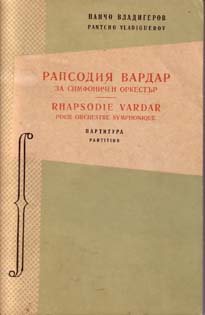
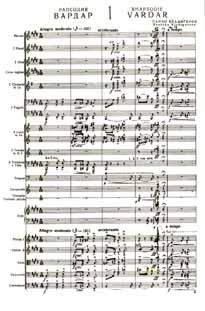
In the name of the bright memory of my teacher Prof. Vladigerov, giving free performance of this concert etude with the only obligation to the contractor to provide a second amateur record and a copy of its program (poster) performance.
20.08 2008, Friday - 07.09 2008, Sunday
/ villa: "Lina", v.Emona, Bulgaria /
Please see full part of this work in printed form [PDF version].
In a possible interest in the work, please contact us through our e-mail.
